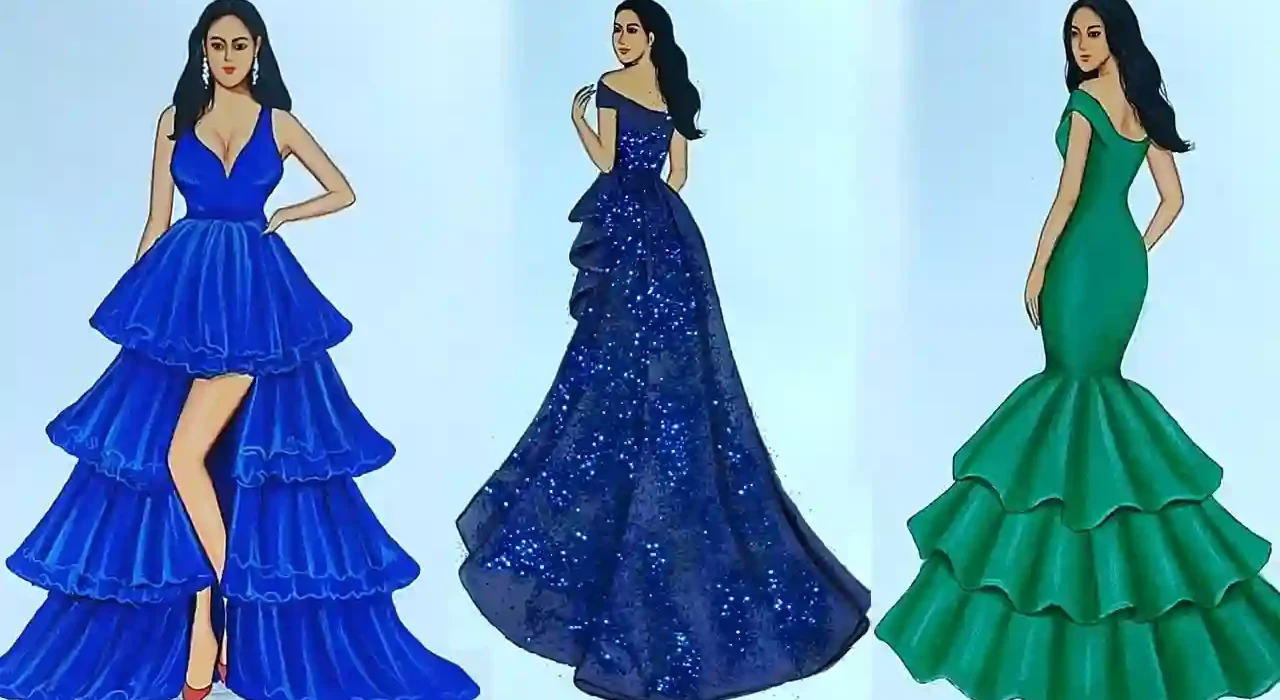Texture and fabric are the soul of fashion. They give life to clothing, adding depth, richness, and tactile interest to designs. In the world of fashion design drawing, the ability to express texture and fabric convincingly is a crucial skill. In this article, we will explore various techniques and tips for effectively conveying texture and fabric in your fashion design sketches.
1. Understanding the Importance:
Texture and fabric are essential elements in fashion design. They play a significant role in the look and feel of clothing. To create compelling fashion design drawings, it’s crucial to master the art of expressing different textures and fabrics realistically.
2. Study Real Fabrics:
Start by studying real fabrics. Examine a variety of textiles, from silk and satin to denim and wool. Pay attention to how these fabrics drape, fold, and crease. Observe the texture and surface details, such as the sheen of satin or the roughness of denim.
3. Use Reference Images:
Gather reference images of different fabrics and textures. These images can serve as valuable references when creating fashion design drawings. Analyze the reference images to understand how various fabrics appear in different lighting conditions.
4. Practice Observation:
Develop your observation skills by closely examining clothing items in your wardrobe or at a clothing store. Look at how fabrics behave when worn or displayed. Notice how light interacts with different textures and materials.
5. Start with Basic Shapes:
Begin your fashion design drawings by sketching the basic shapes of the garment. Establish the overall silhouette and structure of the clothing before adding texture and fabric details.
6. Experiment with Lines:
Lines are an essential tool for conveying texture. Use varying line weights and styles to suggest different textures. For instance, use short, quick lines for a rough texture like denim and long, flowing lines for a smooth texture like silk.
7. Employ Hatching and Cross-Hatching:
Hatching and cross-hatching are shading techniques that can add depth and texture to your fashion sketches. Hatch lines in the direction of the fabric’s texture to simulate its appearance. Cross-hatching can be used for more complex textures.
8. Master Shading:
Shading is a fundamental technique for creating the illusion of three-dimensional form. Consider the direction of light in your fashion design drawing and shade accordingly to create highlights and shadows that define the fabric’s texture.
9. Pay Attention to Folds and Drapery:
Folds and drapery are essential aspects of expressing fabric in fashion sketches. Observe how fabric gathers and drapes around the body. Use curved lines and shading to depict the folds and wrinkles realistically.
10. Experiment with Different Materials:
Explore various drawing materials to enhance texture representation. Charcoal, conte crayon, and pastels can be effective in conveying fabric textures due to their tactile nature and ability to create soft or bold lines.
11. Add Surface Details:
Surface details such as buttons, zippers, stitching, and embroidery contribute to the texture and character of clothing. Pay meticulous attention to these details in your fashion design drawings, using fine lines and small marks to represent them accurately.
12. Mix Media for Realism:
Consider using mixed media in your fashion design drawings. Collage actual fabric swatches onto your sketches to showcase the materials you intend to use in your designs. This adds a tactile element and authenticity to your drawings.
13. Digital Tools and Textures:
If you work digitally, explore digital tools and texture brushes to simulate fabric textures. Many illustration software programs offer a wide range of brushes that mimic fabric weaves and patterns.
14. Experiment with Fabrics Patterns:
Fabrics often feature patterns and prints. Practice incorporating different fabric patterns, such as plaids, florals, or stripes, into your fashion sketches. Pay attention to how patterns interact with the garment’s form.
15. Create Texture Maps:
For digital fashion designers, creating texture maps can be an effective way to map different textures onto 3D garment models. Texture maps allow you to simulate a wide range of fabrics and materials realistically.
16. Seek Inspiration from Fashion Photography:
Fashion photography can provide valuable inspiration for expressing texture and fabric in fashion design drawings. Analyze high-quality fashion photographs to understand how textures are captured in real-life clothing.
17. Develop a Fabric Swatch Library:
Create a fabric swatch library that includes samples of various textiles and materials. Refer to this library when working on your fashion design drawings to ensure accuracy in texture representation.
18. Study Fashion Illustration Masters:
Study the works of renowned fashion illustration masters. Analyze how they have depicted texture and fabric in their sketches. Their techniques and styles can offer valuable insights and inspiration.
19. Practice, Practice, Practice:
Like any skill, mastering the art of expressing texture and fabric in fashion design drawings requires practice. Dedicate time to regular practice sessions where you focus specifically on texture and fabric representation.
20. Seek Feedback and Critique:
Share your fashion design drawings with peers, mentors, or online communities to receive feedback and constructive critique. Collaborating with others can help you identify areas for improvement and refine your texture-rendering skills.
In conclusion, mastering the art of expressing texture and fabric in fashion design drawing is a journey that requires dedication and a keen eye for detail. As you incorporate these techniques and tips into your fashion sketches, you’ll find your ability to bring clothing to life on paper improving. Let texture and fabric be the signature elements that elevate your fashion design drawings, allowing your creative vision to shine through with authenticity and realism.


